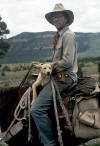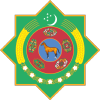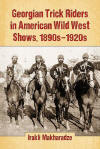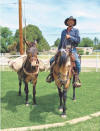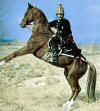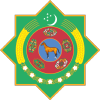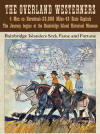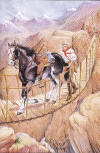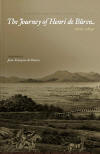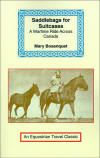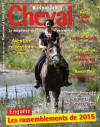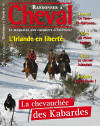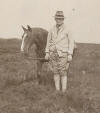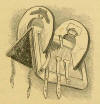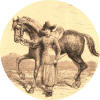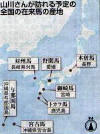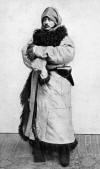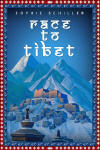|
Australia’s Little Long Rider sets a Record
The year was 1932. Despite the onset of the Great Depression, Australia was preparing to celebrate the opening of the Sydney Harbour Bridge. Lennie Gwyther was a nine-year-old farmer’s son who lived 1000 kilometres away. Undaunted by the distance, Lennie mapped out a route and then set off on his pony, Ginger Mick. As news of the small boy’s journey spread, the Australian public became keenly interested. After travelling for four months, Lennie was given a hero’s welcome by Sydney’s mayor (right). Then he turned around and rode home.
Though younger children made journeys, Lennie is the youngest known person to make a solo equestrian expedition. This has earned him a special place in the Guild’s Records.
An article recounts Lennie’s story. Another report explains how the equestrian journey inspired a children’s musical. And a book has been published about the ride. |
 |
|
Australian Carries LRG Flag Along Historic BNT Trail
Kimberley Delavere, who has set off to ride the length of the Bicentennial National Trail, will be the first person to carry the Guild’s flag across the Australian continent.
In addition to raising support for the Indigenous Literacy Foundation, Kimberley’s hopes to honour the legacy of Historic Long Rider Lennie Gwyther, who rode across Australia at the age of nine.
The young equestrian traveller was mentored by Australian Long Riders Sharon Muir Watson and Sharon Bridgeman, both of whom previously rode the BNT. Kimberley’s pack horse is equipped with an adjustable pack saddle from Custom Pack Rigging, which has provided valuable assistance to equestrian explorers around the world. |
 |
|
The Guild Welcomes New Members Donna and Nic Cuthbert rode from Sagsay soum, Bayan-Ulgii aymag, Western Mongolia to Baganuur, Tov aymag, Eastern Mongolia. The Long Riders discussed the challenging journey on the Mongolian television programme, “Talk With Me.” |
 |
|
“Let the Tears Flow” An emotionally powerful “Story From The Road,” written by Australian Long Rider Donna Cuthbert, reveals the hidden heartbreak which lies like an undetected threat at the end of many equestrian journeys. |
|
|
Story of Historical Long Rider Recovered The account of Belinda Fane’s journey from Gosford, New South Wales to Perth in Western Australia has been received by the Guild. Originally from England, Belinda made her 1500 kilometre ride in 1963. An article, written by Belinda, provided vital details of the trip. The story is now available in the LRG News Archive. |
|
|
Lithuanians pioneer equestrian route around their country In 2011 Vaidotas Digaitis was one of a group of Long Riders who re-rode a historic trail from the Baltic Sea in Lithuania to the Black Sea in Ukraine. Vaidotas then set out alone to make a journey around the Baltic Sea to the Arctic Circle and back. The dedicated Long Rider has now led a group of equestrian travellers who have pioneered a route around their native republic of Lithuania. All of the journeys have been made using Zemaitukai horses, the historical breed of Lithuania. |
 |
|
The Guild Welcomes New Member Marc Noonan rode across Colombia, through Ecuador and on to the border with Peru. |
 |
|
New Testimonial from Friend of the Guild, Pablo Lapasset (right) of Argentina A few days ago I read my seven-year- old son, Ignacio (left), the story of how nine-year-old Lennie Gwyther rode 1,000 kilometres across Australia in 1932. The night before, I myself had read the incredible story of the Cossack Long Rider, Alexandra Kudasheva, who rode alone across Siberia twice. I was shocked by her leadership as an active officer during the First World War. These two stories are just part of the knowledge that the Long Riders’ Guild offers to people like me, who share an interest in horses, history, nature, horseback travelling and all its common areas. At the same time I have just finished reading “The Victorian Horse World” and almost every night I read Ignacio a chapter of “Gato y Mancha,” I learned about these books thanks to the Long Riders’ Guild, and because they are not available in Argentine bookshops, purchased them via an international bookshop. Thanks to technology, it is amazing how you can become informed if you search in the correct place. Knowledge acquired on-line, and via traditional printed books, came into my world thanks to the Long Riders’ Guild. It is because of their efforts that we are able to obtain this information here at home in the pampas of Argentina. But someone has to undertake the hard work of compiling all this wisdom and it is the LRG that does this duty. Another very important task the Guild accomplishes is the collection and distribution of stories about our equestrian past. These tales are saved from vanishing and are transmitted to a younger generation of riders and dreamers. This important work is a link between the past and future and will be appreciated by our sons and grandchildren. These various types of equestrian knowledge represent an element of recreation and education for my children and me. By becoming informed about current Long Riders and historic rides from the past, we dream about our own expedition in the future. For all I have tried to explain I say “Thank You!” Your hard work is really valuable to us and I hope at least some of your aims are covered in knowing we appreciate all your efforts. |

|
|
Hoofprints Across Patagonia
Capucine Lelièvre, Charlotte Simsar and Charlotte Vandeputte began their journey across Patagonia. Riding 2,000 kilometres from Bariloche to El Calafate, will require them to spend six months in the saddle.
Yet they have expressed a desire to protect the welfare their horses and to interact with the Argentine people. “The objective of this adventure is not to rush and lock in as many kilometres as possible but to tune in with the environment and people we meet.”
Prior to their departure, the team was mentored by the French Long Riders Stéphane and Véronique Bigo, who have ridden on many continents and across several countries, including Turkey, China, Ethiopia, Brazil, Guatemala and the United States. The team are using one of the Canadian adjustable pack saddles which were donated to the Long Riders’ Guild and are undergoing an unprecedented ten-year field test. |
 |
|
Red’s Ride from Columbia to Peru Thanks to English Long Rider Marc Noonan, a modern route across Colombia and Ecuador has been carefully documented. |
|
|
Luján Museum Reveals Historic Image of Mancha and Gato
“Tschiffely’s Ride” is rightfully considered to be the most influential equestrian travel book written during the 20th century. When the classic adventure tale was re-published in 1952, the author included a special Postscript, wherein Aimé Tschiffely wrote movingly about the deaths of Mancha and Gato, the horses that accompanied him on the famous journey from Buenos Aires to New York.
After their deaths the remarkable Criollo geldings were preserved and given a place of honour at the Luján Museum in Argentina. In response to a request from Basha O’Reilly, the Executor of the Tschiffely Literary Estate, Senor Andres Mage, the museum’s curator, along with Mariana Luchetti, the librarian and Gladys Scarato, who oversees conservation and restoration, have begun reviewing the museum’s collection of Tschiffely artifacts, photographs and images. Their research has already revealed many exciting discoveries.
This image, which has not been viewed by the public for many decades, is believed to be the first photograph taken of Mancha and Gato as the museum prepared to place the famous road horses on display. |
 |
|
Tschiffely’s Silver Dagger
The Argentine association of Criollo horse’s breeders issues an annual magazine. The 1928 edition carried a special article about Aimé Tschiffely’s journey from Buenos Aires to New York. That commentary contains images not presented in any other publication. Included in the story are the first known photographs of the special Argentine facón (dagger) presented to the Tschiffely at the conclusion of the celebrated ride, a detailed map of the Long Rider’s route across the Americas, and an image showing the Long Rider being welcomed into the United States by American cavalry officers.
Basha O’Reilly, the Executor of the Tschiffely Literary Estate, would like to thank the Luján Museum in Argentina for preserving and sharing this historically important document. |
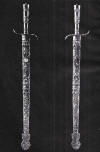 |
|
Theft of Tschiffely Images Results in Reporter Losing Job
Thanks to a sharp-eyed Long Rider, the Guild was alerted to an internet news story which contained four historically important images that had been taken without permission from the official Tschiffely website. Among the photographs was the one showing the famous Swiss Long Rider being greeted by the mayor of New York city.
The TLE website clearly states, “All information and images on this website copyright (c) 2008-2015 The Aimé Tschiffely Literary Estate, Basha O'Reilly, Executor. The use of any of the copyrighted images is prohibited without prior written permission. Any violation will be strictly and immediately enforced.”
When informed of the violation, the Indiana-based publication responded within eight hours. As a result of an internal investigation, the offending article was immediately removed, an apology was issued, the staff received training about the importance of copyright protection and the reporter in question resigned. |
|
|
Argentine Adventure to be recounted in new book
In 1999 Benjamin Reynal set off with his two Criollo geldings, Pampa and Federal on a 5,000 kilometre journey through 15 provinces of Argentina. At the conclusion of the ride, the annual edition of the Criollo breeder’s magazine published an article about this pilgrimage across the pampas. Editorial Planeta, the world’s largest Spanish language publisher, has just announced plans to release Benjamin’s book about this important equestrian journey. |
 |
|
Long Rider Author Passes Away
Diana Pullein-Thompson, one of a trio of horse-mad sisters who became synonymous with children’s equestrian books, has passed away at the age of 90.
Josephine, Christine and Diana were the daughters of Joanna Cannan, a prolific novelist who is credited with inventing pony stories for children, beginning with “A Pony for Jean” (1936). Diana was nine when her story, “The Life of a Carthorse”, appeared in a magazine. She wrote her first book, “I Wanted a Pony”, at the age of 14. Between them, the Pullein-Thompson sisters wrote more than 150 books that were populated by unforgettable equine characters and the children who loved and rode them.
A founder member of the Children’s Writers Group of Great Britain’s Society of Authors, Diana’s 30 equestrian novels rejected the prevailing concept that horses were reserved for the rich. In 1996 the fearless rider, who broke and schooled horses, based her last book, “The Long Ride Home” (right) on the journey she made with her grey mare, Favorita, from John O’Groats, Scotland to Land’s End, Cornwall in 1956. |
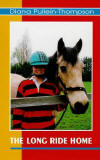 |
|
Documentary Describes Equestrian Journey from Patagonia to Alaska
Russian Long Rider Vladimir Fissenko and American Long Rider Louis Brunke (right) had no idea what awaited them when they made plans to ride from the southern tip of Argentina to Prudhoe Bay, Alaska. The journey lasted five years (1988-1993), required them to cross the treacherous Darien Gap jungle and ultimately took them across fourteen countries. Along the way Vladimir was savagely attacked and nearly killed in the Andes Mountains. Despite all the challenges, the Russian film maker shot thousands of feet of film. The story of this remarkable journey has now been released in a documentary film. |
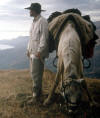 |
|
Rare Film Recounts Ride from Turkmenistan to Moscow
In 1986 Geldy Kyarizov recognized a desperate need to save Turkmenistan’s endangered Akhal Teke horses. To attract the attention of officials in the Soviet Union, Geldy organized a 4,300 kilometre equestrian journey from Ashgabat to Moscow. The ride, which took him across Uzbekistan and Kazakhstan, required him to ride 360 kilometres across a waterless desert.
Upon his arrival at the Russian capital, Geldy successfully petitioned Soviet Union government officials to intercede on behalf of Turkmenistan’s horses. His induction into the Guild marked Geldy as the first Turkmen Long Rider in the history of modern equestrian travel.
A film showing Geldy making the historic journey has been found and is now publicly available. |
 |
|
Missing in Action Long Rider Rupert Hitzig Sought
Equestrian journeys have inspired Long Rider authors such as Somerset Maugham, Jonathan Swift and Graham Greene. One ride also encouraged the making of a well-known Hollywood western film.
Four young people set off on horseback in the summer of 1953. Their mission? To ride 2,300 miles from Austin, Texas to Bearsville, New York. Nini Galpin, a 23-year-old university student organized the journey. Her friends, 17-year-old Cayla Hitzig and 16-year-old Bruce Whitley came along. The youngest member of the group was 14-year-old Rupert Hitzig. After spending 109 days in the saddle, the quartet of Long Riders arrived at their destination. Along their way they had their share of adventures, including nearly being arrested in Wellston, Ohio because police believed they were “gypsies.”
Rupert Hitzig (right) went on to work in Hollywood, where he produced the western film, “Cattle Annie and Little Britches,” starring Burt Lancaster. In an interview, Rupert said, “I always wanted to do a western because when I was 14 I rode across the United States on a horse. A hundred and nine days in the saddle. They wrote about it in the New Yorker magazine.” |
 |
|
Astonishing Discovery – Lady Long Rider Crosses Siberia alone – TWICE! “Queen of the Cossacks” recounts the amazing adventures of Alexandra Kudasheva, the courageous Russian Long Rider who rode through China, Manchuria, Siberia and Europe, then went on to lead 600 Cossacks into battle during the First World War. The celebrated Long Rider, who was befriended by Czar Nicholas II, met a tragic end and her incredible story was lost for nearly a century. The Guild would like to thank Australian Long Rider Tim Cope who informed us of Kudasheva’s important equestrian exploits. |
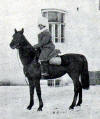 |
|
The Long Riders’ Guild welcomes its newest Members Marcelo Malbran (left) and Osvaldo Lopez (right) rode from the Pacific Ocean at Miramar, Argentina across the Andes Mountains to the Atlantic Ocean at Pichilemu, Chile on a special journey known as the “Peace Ride.” |
 |
|
Historian Dares Hollywood to Defend Hopkins In 2004 the History Channel requested help from the Long Riders’ Guild in determining the accuracy of tales told by a charlatan named Frank Hopkins. The Guild discovered and documented the “Hopkins Hoax,” the most extensive equestrian fraud in American history. When the Walt Disney Studio released a movie based on Hopkins’ “true stories,” more than 80 academic experts joined the Guild in denouncing the film Hidalgo as a blatant fabrication and a violation of the public’s trust.
Despite over-whelming evidence to the contrary, Viggo Mortensen, who starred as Hopkins, said at the time, “What makes the story unique and makes Hidalgo unique is the fact that it is true.”
That wasn’t the first time Mortensen expressed such wishful thinking. In an effort to enhance Hopkins’ shattered reputation, Mortensen told the press that he had conversations with several native Lakota who could not speak English. The actor claimed these Native Americans verified Frank Hopkins’ assorted absurd claims, including that he was half Lakota.
In a fiery public rebuke, legendary Lakota scholar Dr. Vine DeLoria Jr. described Hopkins as “the world’s greatest liar” and demanded Mortensen produce his Lakota witnesses. The Hollywood celebrity declined to respond. It’s just as well Mortensen kept quiet because a new discovery confirms that Hopkins was an Indian Impostor. A DNA test voluntarily undertaken by one of Hopkins’ grandchildren revealed “not a drop of Native American blood” could be detected in the family!
Another historical expert has now issued a new public challenge to Mortensen.
Tom Cunningham has spent decades documenting the activities of Buffalo Bill Cody and the Wild West Show. The respected author of books and articles about Cody, Cunningham has an encyclopaedic knowledge about the movements and history of the Wild West Show in Scotland, Great Britain and Europe.
Cunningham warned the public that Hopkins’ original writings are “a ludicrous manuscript that contains myriad eccentricities all of its own,” then went on to say, “The film is only loosely based on Frank T. Hopkins’s tedious and error-laden ‘memoirs’.”
What Cunningham concluded was that screen-writer John Fusco had added a new level of toxic deception to Hopkins’ original dishonesty. The result was a cinematic fraud deliberately mislabelled as a “true story.”
In an effort to draw Mortensen and Fusco out of hiding, Cunningham published the following challenge.
“Anyone able to identify a single shred of independent evidence in support of either Frank Hopkins’s memoirs or the movie which it inspired, particularly with regard to the three decades which he claims to have spent as a star performer with Buffalo Bill, is cordially invited to share their findings!” |

|
|
Long Distance Riders in the 21st Century Will equestrian travel continue in an increasingly motorized age? Cristiano Pereira, a reporter for Portugal’s leading newspaper, interviewed half a dozen equestrian explorers from five countries to find out. This excellent in-depth investigation received an overwhelming positive public response in Portugal and revealed why the lure of Long Riding will endure. Click on picture (right) to read this article. |
 |
|
The Long Riders’ Guild welcomes a new Member Dalibor Balut has completed the first modern ride to all corners of his native Czech Republic. |
|
|
Riding in the Hoofprints of a Hero Long Rider Dalibor Balut has prepared a plan of his route, which includes daily distances and the names of places where he stayed along the borders of Poland, Germany, Austria and Slovakia. Part of his journey took him along the route previously ridden by Jan Žižka (right), a national hero to the Czech people. Considered to be among the greatest military leaders of all time, Žižka is one of the few commanders in history who never lost a battle. |
|
| Chronology of Guild Activities - During the course of its existence, the Long Riders’ Guild has completed many commendable achievements including creating a unique honour society, launching the world’s largest equestrian travel website, publishing hundreds of books, rescuing precious knowledge from extinction, hosting international meetings, supporting equestrian explorers around the world and protecting horses from exploitation. Along the way the Guild has defended Her Majesty, the Queen and found favour with His Holiness, the Dalai Lama. It has also been necessary to help liberate Long Riders who were unjustly imprisoned, to combat cyber crime, to defend literary liberty and to expose the practices of corrupt corporations. A Chronology containing more than 30 years of Guild activities provides more detail. |
 |
|
New Testimonial from the Long Rider who Defied a Tyrant Earlier this year the Guild reported how Geldy Kyarizov rode 4,300 kilometres from Ashgabat to Moscow to save the Akhal Teke breed. The dictatorship of Turkmenistan showed its gratitude by making it a crime for him to touch a horse. While Turkmenistan punished the equestrian champion, others rallied to his defence. Various human rights organisations fought to free Geldy and his family from relentless persecution. The Long Riders’ Guild led an effort to instate Geldy as the first Turkmen Long Rider in the history of modern equestrian travel and the first Turkmen Fellow of the Royal Geographical Society. After enduring thirteen years of political torment, Geldy and his family were freed thanks in part to a campaign waged by the Guild. This photo (right) shows Geldy defying the laws of the Turkmen tyrant by petting an Akhal Teke horse in Moscow. Having escaped persecution, Geldy shared this Testimonial regarding the equestrian campaign which CuChullaine O’Reilly and the Guild carried out.
"If Allah saved my life and the lives of my family and gave me freedom,
it is because not only in action but also in thoughts I have never
betrayed the ancient culture of my people. All my life I fought for the
spiritual and material heritage of the ancient Parthians that the
Turkmens received as a gift from their ancestors. I applaud you, CuChullaine, as a psychologist. You hit the top ten with the first shot. What you said couldn't have been said by any international human rights organization.” |

|
|
Long Riders in the Jungle Horses and jungles don’t mix. Regardless of where the jungle is located, it represents an alien environment to the horse. As Long Riders have learned to their horror, trying to cross a jungle on horseback doesn’t match the Hollywood fantasy. Temperatures soar to 100 degrees Fahrenheit in the shade. Insects suck your blood and drive you mad. Leeches lurk in the swamps you must wade through, waiting to feast on your water-soaked flesh. Vampire bats gorge on your horses at night, leaving them too weak to travel in the morning. There is a shocking lack of food for you and the horses. The undergrowth is so dense you can’t move. The humidity makes it difficult to breathe. Despite the hazards, two renowned American Long Riders ventured into the Central American jungle and made fantastic discoveries. John Lloyd Stephens (top) rode into the jungle on the Yucatan Peninsula in 1838. When he emerged Stephens astonished the world by proclaiming that he had discovered the “lost” city of Copán. Doug Preston (bottom) went into the jungle 177 years later but he too has returned with an amazing tale of locating another forgotten metropolis. In an article for National Geographic magazine, Doug recounts how he went into the Honduran rainforest in search of Ciudad Blanca and subsequently found “the Lost City of the Monkey God.” Time marches on but the terrors of the jungle environment remain constant. Stephens was the first Long Rider to write about encountering one of the most savage scourges of the jungle, the notorious, blood-sucking garrapatas. Generations of Long Riders have since written about their pain-filled encounters with these insects, which are so tiny that they resemble dots of red sand. But size doesn’t matter. When they covered German Long Rider Günter Wamser, he wrote about how they bit and devoured him to the point of madness. “I thought I would tear my skin off,” he later wrote. Doug’s journey was also affected by “swarms of noxious insects, poisonous snakes, jaguars and torrential rainfall.” |
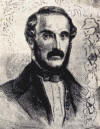 |
|
Long Rider Family Reunited Thirteen years of political torment have come to an end for a Long Rider and his family thanks to a campaign waged by the Guild. Earlier this year the Guild honoured Geldy Kyarizov (left) by naming him as the first modern Long Rider from Turkmenistan. Additionally, the Guild sponsored the equestrian explorer to be instated as the first Turkmen Fellow of the Royal Geographical Society.
An editorial entitled “Divine Horses and Political Injustice” described how Geldy and his family had suffered years of persecution at the hands of the dictator who rule his homeland. The article concluded by stating that the Guild was going to seek the arrest of the Turkmen president on charges of kidnapping and organize an international equestrian boycott against the country.
Following the publication of the LRG’s protest on September 7th, Geldy was permitted to leave the country one week later. But his daughter, Sofia (centre), and sister-in-law, Elena (right), were kept as prisoners by the Turkmen tyrant. After the Guild lodged a second protest with the government, threatening to launch the equestrian boycott, etc., Sofia and Elena were allowed to leave the country four days later.
“When I saw my daughter and sister-in-law as they got off the plane, I was overjoyed,” Kyarizov said. “Seeing them reminded me that the road is long, but if we keep on fighting and keep on walking, we will overcome our obstacles.”
The reunited family (right), including Geldy’s wife, Julia, is seen in Moscow. They are standing with one of the Akhal Teke horses which Geldy is famed for breeding. Articles about the family’s escape appeared in Horse Talk and Explorers’ Web. |

|
|
An Equestrian Pilgrimage from England to Spain The lure of a long-distance ride leads Mefo Phillips to team up with her sister Susie and their spotted Appaloosa horses Leo, a flirt with a passion for Mars Bars, and affectionate Apollo, for a journey along the medieval Way of St. James, an ancient trail leading from Canterbury Cathedral to Santiago Cathedral. Slowed by thunderstorms, vertigo, worn-out horseshoes and a variety of eccentric farmers, it's boiling midsummer by the time they reach the Castilian plains after a meander across lush springtime France. With 1,700 miles, four mountain ranges, and encounters with galloping goats, nude pilgrims and a fountain of red wine behind them, victory seems within sight for the English Long Riders, when they encounter an unexpected obstacle. Mefo’s delightful “Story from the Road” is an extract from her popular book. |
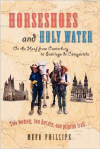 |
|
Iceland Restricts Horse Travel?
The Scandinavian sagas provide ample evidence of how deeply revered the Vikings held the horse. Odin (right) rode the magical eight-footed horse, Sleipnir. So long as a Viking was healthy enough to ride a horse his property could not be divided. After landing in a foreign country, Vikings were quick to take to the saddle and raid inland. They also exported horses to their colony of Iceland. The horses of Iceland are famous for their smooth gait and the country has long attracted equestrian travellers. However information sent to the Guild indicates that Long Riders may no longer be welcome in the island nation. According to a message sent by an experienced Long Rider, Iceland is believed to have enacted two laws which appear to make equestrian travel effectively illegal. One law is purported to state that horses cannot be ridden for more than 20 kilometres (12.5 miles) per day. A second law is believed to state that horses may not be ridden for more than ten days. The Guild is seeking confirmation of this draconian legislation but travellers should be warned that the days of riding in freedom like the Vikings of old seem to have been outlawed in Iceland. |
 |
|
The Death of Napoleon’s Horses General William Carter served with the United States Calvary and was considered one of that country’s foremost equestrian experts. His book, Horses, Saddles and Bridles, which is published by the LRG Press, covers a wide range of topics including training of the horse. Additionally, Carter provides studies of cavalry campaigns, detailing for example how Napoleon (right) lost so many horses in his ill-fated Russian campaign.
“During the Russian campaign the French crossed the Niemen River in June, 1812 with cavalry, artillery and train horses to the extent of 187,121; about 60,000 of these pertained to the cavalry. Up to this time it had been very hot; an unprecedented rainfall commenced and in a few days the roads became almost impassable, and there was little or no food for the horses. Ten thousand horses were left dead between the Niemen and Wilna Rivers. The only food to be had for the large number of animals with the army consisted of young, growing crops of wheat, rye and barley. Such food is calculated to produce weakness and intestinal troubles of a grave nature, and this was without doubt the cause of most of the loss. General Murat states that half the cavalry perished around Moscow in their search for supplies. It was not the horrors of the icy retreat which used up the animals, for Napoleon caused General Berthier to write to General Victor on November 6, that the cavalry was unhorsed; in all 92,000 horses had succumbed before the fall of the first snow. On December 13, the remnant of the invading army re-crossed the Niemen River with 1600 cavalry. In six months the horses had all disappeared, and there is ample evidence that this was not the result of cold, but of starvation, aggravated, perhaps, by cold towards the end of the campaign.” |
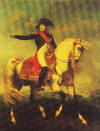 |
|
Legendary Long Rider Dog passes away She never won any beauty awards and her early years were unhappy, but a down-on-her-luck dog named Claire (right) made history when she was befriended by North American Long Rider Bernice Ende. In the subsequent ten years of their friendship, Claire happily rode atop the pack saddle as she accompanied Bernice more than 17,000 miles during their many journeys in the United States and Canada. Because of her advancing age, Claire did not accompany Bernice when she set out in 2014 on the first attempt to ride “ocean to ocean” in both directions on the same trip. Claire the trusty traveller passed away at the age of 16, while faithfully awaiting the return of her Long Rider friend. |
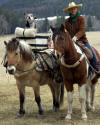 |
|
The Long Riders’ Guild welcomes its newest Member Upon reaching the town of Zunmod, English Long Rider Jack Toulson completed a thousand-mile journey in Mongolia. The equestrian trip is featured on a new website created to celebrate Sir Richard Burton and the Adventurers’ Guild. |
 |
|
Tschiffely book published in Spanish
Most modern readers won’t recognize the name “Lucas Bridges.” But ask anyone from Patagonia about Bridges and you will quickly hear stories regarding “the man from Woodpecker Creek.”
Bridges was a human transition, not only between centuries but also between cultures. His father was an Anglican missionary sent to minister to the indigenous people in a remote region of Tierra del Fuego, Argentina. When Lucas Bridges was born in 1874, the minister’s son was officially recognized as "the third white native of Ushuaia." As a result of his unique childhood, Bridges grew up learning the culture and languages of the Yahgan and Ona peoples.
By the late 1930s Bridges was a living legend in Patagonia, when Aime Tschiffely met him. The renowned Swiss Long Rider and author was fascinated by the life-story of the man who had been an explorer, pioneer, soldier, ethnologist and farmer. In 1953 Tschiffely published an acclaimed biography of Bridges entitled “The Man from Woodpecker Creek.” Because the book has remained a perennial favourite in Patagonia, the Tschiffely Literary Estate has authorized a Spanish translation, which is now available in Argentina. |
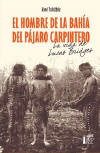 |
|
Historical Long Riders Recalled Equestrian travellers are often inspired to undertake a journey due to the strong influence of those who rode before. Richard St Barbe Baker (right) was one person who rode in the hoofprints of such an Historical Long Rider. In 1958 he set off to re-trace the ride made by William Cobbett in 1820. Mounted on a grey horse called “The Ghost,” St Barbe Baker followed Cobbett’s trail across England. Cobbett wrote a famous book about his journey. Entitled “Rural Rides,” the classic equestrian travel tale is available via the Long Riders’ Guild Press. A recent article in the English press recalls St Barbe Baker’s ride and explains how that Long Rider founded a movement with chapters in more than 100 countries that planted 26 trillion trees internationally. |
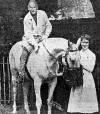 |
|
Long Riders Liberate Political Prisoner Turkmen Long Rider Geldy Kyarizov (right) flashes the “V for Victory” sign after surviving years of political injustice. He was freed following months of intense campaigning by the Long Riders’ Guild.
In April the Long Riders’ Guild was contacted by Gill Suttle, an Akhal Teke breeder who provided evidence proving Kyarizov had made a 4300 kilometre equestrian journey. Suttle also informed the LRG that Kyarizov was the victim of a vicious political persecution campaign carried out by the government of Turkmenistan.
The Guild named Kyarizov as the first modern Turkmen Long Rider in June; ensured that he was instated as a Fellow of the Royal Geographical Society and invited him to attend a forthcoming Long Rider meeting in Switzerland.
Kyarizov and his family were attacked in July and denied permission to leave the country. In response on September 7th 2015 the Guild published an article entitled “Divine Horses and Political Injustice.” The study documented how Kyarizov helped preserve Akhal Teke horses. The Guild's study concluded with the following warning. "If Turkmenistan continues to ignore its own laws and violate the rules of humanity, the Long Riders’ Guild will urge the International Criminal Court in The Hague to investigate President Berdymukhamedov on charges of kidnapping, illegal confinement and violations of human rights. It will place President Gurbanguly Berdymukhamedov in the Guild’s Hall of Shame. It will urge the international Akhal Teke community to boycott Turkmenistan and refuse to attend the nation’s annual equestrian celebration."
In addition CuChullaine O’Reilly sent an email on behalf of the Guild to Yazgeldy Annaev, the director of Turkmenistan’s national Akhal Teke breeding association. That letter stated, “As the Guild study proves, there is no equestrian evidence which justifies holding Geldy Kyarizov and his family in an illegal and unethical manner. It is my sincere hope that as Director of Turkmen Atlary you can help the Long Riders' Guild bring about a peaceful resolution to this long-running problem. However, if no word or action is soon seen from Ashgabat, then the Guild will begin to formulate an international equestrian blockade against the Akhal Atlary; the Guild will declare Turkmenistan's horses to be symbols of political slavery; and the Guild will seek the arrest of President Berdymukhamedov.”
Geldy Kyarizov was freed one week later, on September 14th, and flew to Moscow for urgently-needed medical treatment. Daud, Geldy’s son, wrote, “Our family couldn’t be happier than we are right now. It is safe to say this wouldn’t have been even possible without your help and the help of people who have been fighting on our behalf. I believe your last letter addressed to the minister of horses definitely had an effect and the government finally gave in. You can truly call yourself a human rights defender!”
News of Geldy’s release was immediately shared with the international equestrian community via an article entitled “Freedom for Long Rider” published by the Horse Talk news service. The international exploration community was informed by the Explorers’ Web news service, who published the article “Long Riders Liberate Horseman.” |

|
|
Long Rider held as Political Prisoner – His Family Attacked Earlier this year the Guild announced that Geldy Kyarizov (right) had been welcomed as the first Turkmen Long Rider and instated as the first Turkmen Fellow of the Royal Geographical Society. Kyarizov is one of the world's leading experts on Akhal Teke horses. He is also being held as a political pawn by a Central Asian tyrant. Fearing for his safety, the Guild was reluctant to reveal the tale of tragedy and tears behind Geldy Kyarizov’s story. Yet soon after the Guild announcement, Explorers’ Web published details of how Kyarizov had been falsely arrested, imprisoned in the notorious Ovadan Depe gulag and deprived of medical care. Then Human Rights Watch released the news that Kyarizov’s 14-year-old daughter narrowly escaped death and his sister-in-law was severely wounded after they were targetted by assassins. Turkmenistan, which has been described as “one of the world’s most repressive countries,” is now the focus of intense international scrutiny. A petition, which is circulating among the international equestrian community, urges the Turkmen president to release the Long Rider and his family; Amnesty International is continuing its campaign to defend the family; Great Britain’s Ambassador to Turkmenistan said he plans to discuss the Kyarizov case with Turkmenistan’s Minister of Foreign Affairs and a leading Central Asian news agency is conducting an intensive investigation. While the Guild welcomes these efforts, our focus remains on equestrian issues and horses lie at the heart of the Kyarizov affair. What has been largely forgotten is that Turkmenistan’s Akhal Teke horses were once used as weapons of war (right) to enslave thousands of Persians and Russians. Time marches on but mankind’s ruthlessness endures. It is ironic that Long Rider Geldy Kyarizov’s legendary Akhal Teke stallion, Yanardag, appears on the national emblem of Turkmenistan (right). Yet a special “Word from the Founder” entitled “Divine Horses and Political Injustice” explains how the Akhal Teke horse is once again in danger of becoming a symbol of shame and an icon of political slavery. |
|
|
“Tschiffely’s Ride” the most famous Long Rider book released in Polish
Swiss Long Rider Aimé Tschiffely wrote the most influential equestrian travel book of the 20th century. Entitled “Tschiffely’s Ride,” the book recounts the exciting story of how the young equestrian explorer rode from Buenos Aires, Argentina to New York, USA. The Tschiffely Literary Estate has authorized editions of the classic Long Rider book in Argentina, France, Germany, Great Britain, Italy and the USA. A new Polish edition of the book is now available.
Wyprawa Tschiffely'ego - relacja z konnej podróży, którą autor w towarzystwie dwóch wierzchowców odbył w latach dwudziestych XX wieku przez oba amerykańskie kontynenty - od Buenos Aires do Waszyngtonu DC - od ponad 70 lat zaliczana jest do żelaznej klasyki podróżniczej. Niezwykły wyczyn Tschiffely'ego nawet dziś zostałby uznany za imponujący i od kilku dekad inspiruje kolejne pokolenia podróżników, próbujących dokonać czegoś równie wielkiego. |
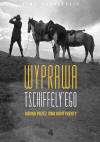 |
|
Signature Book Proves a Success Long Riders past and present have recognized the need to document the accuracy of their journeys. These travellers carried a special “Signature Book” which contained the names of the people they met, along with that person’s signature, date and a personal comment. Argentine Long Rider Benjamin Reynal had the inspired idea of also collecting the signatures of all the policemen he met along the way. He explained, “The reason for this is very important and I would recommend it to future travellers. If you get one policeman to sign your book and stamp it, as I did fifty times, then the next policeman you find will also want to sign, to be part of your trip, to have his picture taken with you.” Benjamin’s Signature Book idea is now being used in the Czech Republic where Dalibor Balut (right) is making a thousand-mile ride. Dalibor emailed the Guild to report that his journey is progressing well and that he is collecting signatures along the way. |
|
|
Expedition News - Solo Journey from Germany to Spain Completed In 2014 Sabine Keller (right) and Dagmar Blöß rode from Cologne, Germany to Saintes Maries de la Mer in the Camargue region of France. After completing her ride to the Mediterranean, Sabine set off on a solo journey this year. In the company of her pack horse, Marenga and her road horse, Isis, Sabine travelled from “the west of Germany to Luxembourg, Belgium and across France to the Atlantic Ocean near Biarritz.” |
|
|
Mugging in Mongolia – Another Horse Theft on the Steppes
The Long Riders’ Guild routinely receives messages from people who are anxious to make an equestrian journey. While most of these queries are sent after careful consideration, some demonstrate how naïve people can be. For example a Frenchman recently wrote to ask advice on how he could a) buy an Appaloosa in America’s “Old West, b) ride through Wyoming with cowboys c) cross the Rocky Mountains d) spend time on a Native American reservation and e) sell the horse to a good home – all in six weeks! As this case demonstrates, experienced Long Rides know that reality must always take precedence over equestrian romance.
Searching for traces of the Old West appeals to a few people; but it is Mongolia that attracts the largest number of ill-informed would-be equestrian travellers. Every year the Guild receives messages from people in many countries, all of whom harbour a number of serious misconceptions about Mongolia. There is certainly no denying that Mongolia has an impressive equestrian culture that spans centuries. Plus the country has millions of horses and a vast steppe to ride across. What is often misunderstood is that the nomads who reside and ride on the steppe may take advantage of travellers.
David Grant, the Scottish wagon traveller who journeyed around the world, was crossing Mongolia with his family when they were attacked by drunken locals. When David protected his children he narrowly escaped being put into prison. It may be argued that the Grant family’s experiences were exceptional. Yet what cannot be denied is that modern Mongolia has a well-deserved reputation for being the worst country in the world for horse theft. Five Long Riders have had their horses stolen since 2004.
Things have now taken a turn for the worse on the steppe. No lady Long Rider has been attacked and robbed since French Long Rider Laura Bougault was assaulted by Zulu bandits in 2003. Sadly, the Guild has been informed that Australian Long Rider Donna Cuthbert was forcibly robbed by Mongols. A few days later the pack horse used by her and Nic, Donna’s husband, was stolen.
There are several things which make these two criminal acts of importance. Nic and Donna are highly experienced international travellers with thousands of miles under their belts. But these seasoned journeyers were taken by surprise by two Mongol thieves. The men drove up to the Australians' camp on a motorcycle in broad daylight. One man dismounted and walked towards Donna. Nic, who was a short distance away, did not have time to react when the Mongol grabbed Donna, pulled the backpack containing all of her valuables off her back, dashed back to the motorcycle and escaped across the steppe. A few days later the Cuthbert’s pack horse Choco was stolen.
The photo of Donna making the campfire (top) shows the romantic ideal which continues to surround Mongolia. The photo (bottom) shows Choco, who was never recovered. Have Mongol thieves become so financially desperate that they are now involved in what would be termed a "mugging" if we were talking about New York's Central Park? While the Guild cannot answer that, what we can do is pass on the news that the Canadian embassy has issued an update which urges travellers to “Exercise a high degree of caution due to increasing crime.” In other news, climate change is threatening the nomadic lifestyle in Mongolia, with 90% of the landscape degrading into desert. |
 |
|
Honesty, Humility, Courage and Compassion English Long Rider Grant Nicolle rode his horse, Marv, along the historic trail that stretches from John O’Groats in Scotland, across England, to Land’s End in Cornwall. A new book entitled “Long Trot” invites the reader to travel with Grant and Marv. Along the way you experience the warmth of Grant’s supportive family, the companionship of dear friends and the generosity of curious strangers. You venture into picturesque villages with names like Puddington, Black Dog and Trispen. You visit secluded farms where you sit down to a dinner of venison casserole, homemade cider and rhubarb crumble. You slow down and see Scotland and England like they did, at three miles an hour. Plus, in a special “Story from the Road,” Grant recounts the first week of his journey, which ranged from being nervous about setting off to rescuing his horse from quicksand. Finally, Grant has prepared a plan of his route, which includes daily distances and the names of places where he stayed. Thus the book, story and route serve as an open invitation for would-be Long Riders to saddle up and follow in their hoofprints. |
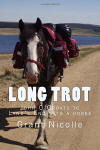 |
|
New York Times Interviews Australian Long Rider Tim Cope set off in 2004 to ride from Mongolia to Hungary. The 6,000 mile journey, which took him more than three years to complete, inspired Tim to write “On the Trail of Genghis Khan.” The New York Times interviewed Tim, asking him to discuss his journey and to provide details about the new paperback edition of his remarkable book. The image (right) shows Tim at Khokh Nuur (Blue Lake) in western Mongolia. |
 |
|
D'Artagnan horse trail follows path of famed Musketeer Long Riders will soon be able to follow the trail of France's most famous Musketeer, d’Artagnan, under a project launched in the town where he was born 400 years ago. Charles de Batz-Castelmore, count of d'Artagnan, was a real-life figure who served King Louis XIV as captain of the Musketeers of the Guard. His sword-wielding adventures were fictionalised in "The Three Musketeers" by 19th-century novelist Alexandre Dumas. Due to open in 2017, the 4,000-kilometre (2,500-mile) "D'Artagnan European Route" will stretch from his home town of Lupiac in south-western France to Maastrich in the Netherlands, where he died during a siege in 1673. Annotated with moments from d'Artagnan's life, the trail will take riders through six countries visited by the Musketeer -- France, Belgium, the Netherlands, Germany, Italy and Spain. |
 |
| The Long Riders’ Guild welcomes new Member. Australian Long Rider Nick Johnston has completed a thousand mile journey in eastern Mongolia. |
|
|
Preserving the Freedom to Ride “Wherever the Heck I Want”
American Long Rider Hetty Dutra grew up on her father’s 10,000 acre ranch. “There was never a time when I didn’t know how to ride,” Hetty explained in a special on-line video interview.
Later in life, when a series of personal problems caused her trouble, Hetty set out on an equestrian journey that would “put my heart, soul and body back together again.”
That journey took Hetty along the Nez Perce Trail in 1994. Twenty years later she re-traced her original journey, making Hetty the only Long Rider to have ridden the famous Native American trail twice.
However in the video Hetty voiced her fears that an increasingly urbanized environment is threatening her right to ride. “What I find most galling about contemporary life is the inability to get on my horse and go wherever the heck I want!” |

|
|
Celebrated Road Horse Passes Away
Anyone familiar with modern equestrian travel will know the story of an unlikely pair of heroes – Howard and Misty.
Howard Wooldridge had spent many years in law enforcement but lacked any knowledge of how to ride “ocean to ocean” across America. Misty the Pinto mare had lost her right eye. That didn’t stop them from setting off in 2002. The photo (right) shows them at their final destination, the Pacific Ocean.
What makes their story so unique is what happened afterwards.
Howard and Misty became highly visible advocates against the “war on drugs.” Representing LEAP, Law Enforcement Against Prohibition, the Long Rider and his horse made a second crossing of the United States in 2005. During the subsequent years Misty was seen by countless thousands as she and Howard campaigned in various states.
In addition to her political life, Misty was also an equine author. “Misty's Long Ride” recounts the story of her first journey across North America with her Long Rider. Misty; road horse, political campaigner, author and friend passed away at the age of 21. |
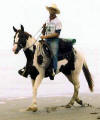
|
|
New Testimonial: Friend of the Guild Wayne P. McCrory is the co-author of a DNA study which revealed how the wild horses protected by the Xeni Gwet'in and Yunetesi'in Native Americans in the remote Brittany Triangle of British Columbia have a genetic link to Siberia’s Yakut horses.
Knowing the extensive network of First Nations horse trade and travels once horses arrived in British Columbia in about 1750, I was aware of the extremely long journeys throughout the grasslands which they made on horses.
It was delightful to learn that the Long Riders Guild Academic Foundation exists to celebrate horsemen world wide, both in the distant past and to this day and that it promotes all kinds of open discussion about horses and their history.
I very much appreciate the publicity the LRGAF has given our findings regarding Canadian and Yakut horse ancestry; and the follow-up information the Guild provided from their research on the predator-prey relationship between horses and wolves.
Hats off to the fine Guild and all of you Long Riders and the horses of the universe that bear you on your travels. |
|
|
Image of Historical Long Rider Discovered. The Old West was populated by a host of colourful characters including gunfighters, cowboys, buffalo hunters, sod busters, and at least one cavalry officer with the eye of an eagle and a penchant for fine writing. Colonel James Meline was an educated New York journalist, turned pony soldier, who had fought for the Union during the recent Civil War. With the country lulled into an uncomfortable peace, the fifty-four year old Meline decided to partake of one last mounted adventure before he hung up his spurs. Lucky for the history of equestrian travel that he did. The resultant book, Two Thousand Miles on Horseback is a beautifully written, eye witness account of a United States that is no more. Meline was no fool. He sensed that the great American wilderness was about to be tamed. Setting out from Fort Leavenworth in the summer of 1866, Meline observed a nation on the move. In his first week in the saddle Meline counted 680 wagons heading west. Moreover, he warned, “the iron rail will soon clamp East and West, leaving no room for adventure or personal freedom.” Meline faithfully recorded the details of prairie life seen during his ride to Santa Fe. Once he reached fabled New Mexico the saddle-borne scribe fell in with Kit Carson. What followed was a three day marathon interview wherein the legendary frontiersman regaled the cavalry journalist with tales of fighting the Navajo, hunting gigantic grizzly bears, and eluding capture by Indians. Then, with his notebooks full, Meline headed home, experiencing a storm on the way that was so cold that “even my memory froze.” Though the frontier they inhabited is a thing of the past, Meline and his cast of mounted characters still jump off the pages and dare you to ride down the road of adventure with them. |
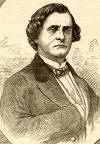 |
|
New Documentary proves “Dreams Do Come True”
The Long Riders’ Guild received an email in August, 2011. The message was sent by a young man named Filipe Leite (right). He wrote to say that his father had read “Tschiffely’s Ride” to him at a young age. The tale of how Swiss Long Rider Aimé Tschiffely had ridden from Buenos Aires to New York had inspired Filipe to make his own equestrian journey.
Filipe’s plan was to ride 16,000 kilometres from Canada to Brazil. The problem was that he had no horse, no saddle, no money and no equestrian travel experience.
The Guild informed Filipe that dreams have no expiration date and that a lack of experience need not deter his plans. The LRG then set about providing Filipe with an unprecedented amount of support, including providing him with an adjustable Canadian pack saddle. After having received equestrian travel training from Canadian Long Rider Stan Walchuk, Filipe set off in July 2012.
During the subsequent two years Filipe endured hardships, survived dangers and met many wonderful people on his way across the Americas. Filipe was joined by his father, Luis, during the Mexican portion of the ride. Finally, after having taken his horses through 12 countries Filipe entered Brazil to a storm of publicity in August, 2014.
This remarkable journey was documented by Outwild TV and a preview entitled “The Long Ride Home” has just been released. The feature length film will soon be available. |
|
|
Equestrian Historian releases book and film about legendary horsemen Irakli Makharadze has spent years documenting the unique equestrian history of his nation of Georgia, which is located in the Caucasus region of Eurasia. In a special article published by the Long Riders’ Guild Academic Foundation, Irakli explains how the Horsemen Daredevils became the star attraction in Buffalo Bill Cody’s Wild West Show. |
|
|
One Last Ride Charles Kitchen is riding from Texas to Montana for a special reason. He plans to spread his father’s ashes in the Yellowstone River. A news report provides details of how the Long Rider is accompanying his father on “one last ride.” |
|
|
Long Riders Charged with “Environmental Crimes”
In past centuries equestrian travellers were forced to avoid attacks by savage animals and murderous natives. Modern Long Riders are required to overcome challenges from a new type of enemy – hostile national governments and aggressive local police.
The Guild has received reports that Long Riders in various countries are being charged with "environmental crimes" That is a new way of saying that you will be arrested if you are discovered riding in a national park or if you are found sleeping alongside a road.
A terrible example of the latter recently happened in California. An elderly man was travelling through a small town with his mules. Local police stopped the traveller. When they realized that he had not actually broken any laws, the authorities seized the traveller and took him to a local mental hospital for "observation."
On another occasion this traveller was issued with a ticket (seen right) costing $485 because he was discovered camped alongside a California road.
Another alarming example of government antagonism has been recorded by Marc Noonan, who is riding from Columbia to Peru. Marc wrote to say that soon after he rode into Ecuador’s Cotopaxi National Park he was stopped by four park rangers.
“They demanded to see my documents and asked what I was doing. It would appear that pets are not allowed in the National Parks and my horse Red was classed as a pet. This thought had never entered my head. Travel companion, yes. But I never think of Red as a pet. The conversation got heated when the rangers threatened to take Red and impose fines on me.”
Marc avoided being arrested but he “was forced to leave the park, fined and disillusioned.”
These incidents are an important indication of how modern motorized society is increasingly antagonistic against horse travellers. |
|
|
The Long Riders’ Guild welcomes its newest Member.
In the late 1980s Geldy Kyarizov recognized a desperate need to save Turkmenistan’s endangered Akhal Teke horses.
To accomplish this noble purpose, Geldy rode 4,300 kilometres from Ashgabat to Moscow. The journey, which took him across Uzbekistan and Kazakhstan, required him to ride 360 kilometres across a waterless desert. Upon his arrival at the Russian capital, Geldy successfully petitioned Soviet Union government officials to intercede on behalf of Turkmenistan’s horses.
His induction into the Guild marks Geldy as the first Turkmen Long Rider in the history of modern equestrian travel.
In the following years after his ride, Geldy made valuable contributions as an historian and breeder of Akhal Teke horses.
Geldy’s most renowned success was an astonishing Akhal Teke stallion named Yanardag. The president of Turkmenistan chose Geldy’s horse as the national symbol (right) of the country
Because of Geldy’s contributions to equestrian exploration and science, he has been named as the first Turkmen to be made a Fellow of the Royal Geographical Society. |
|
|
New study uncovers
equine DNA link between Canada and Siberia The first DNA study of wild horses in the remote Chilcotin area of British Columbia has revealed a surprising discovery. The Canadian horses share DNA traits with the Yakut horses of Siberia. In their report, Dr. Gus Cothran of Texas A & M University and Wayne P. McCrory RPBio wrote, “This raises the possibility that horses from Russia may have contributed to the feral herds at some time in the past, which is not outside the range of possibilities.” Such an interaction, the study hypothesised, may have occurred when “the Yakut horse bloodlines arrived in the remote Brittany Triangle of British Columbia from Russian fur traders along the adjacent Pacific Coast.” A special illustrated report published by the Long Riders' Guild Academic Foundation explains how the wild horses protected by the Xeni Gwet'in and Yunetesi'in Native Americans may reveal a previously undetected link between North America and Asia. |
|
|
Longest 20th Century Horse Journey Honoured In 1912, four riders embarked on a 20,000 mile trip to all 48 American state capitals. The idealistic young men dreamed that their gruelling three-year odyssey through deserts, mountains and swamps would make them famous. Instead, they rode into oblivion. Known as the Overland Westerners, their tragic tale became a Long Rider legend. Thankfully a brilliant investigative article by noted Washington journalist Tristan Baurick has brought this neglected story out of the shadows. Complete with photographs taken during the journey and enriched by explanatory videos, the article entitled “The Longest Ride” is the finest example of equestrian travel reporting seen in many years. |
|
|
Rare Film Footage of Tschiffely’s Ride In 1925 Swiss Long Rider Aimé Tschiffely set out on an epic ride with two Criollo horses, Mancha and Gato. The explorer's goal was to travel ten thousand miles from Buenos Aires to Washington, DC. The mounted odyssey lasted two and a half years, forcing horses and rider to survive near-impossible conditions, including crossing an infamous swinging bridge in the Andes Mountains. The Lujan Museum near Buenos Aires, which protects many important Tschiffely artefacts, has released a special film which shows Tschiffely, his horses, and the ticker tape parade they received upon their entry into New York city. Argentine Long Rider Benjamin Reynal has kindly shared the short film with the Guild. |
|
|
Land’s End Long Riders Traditionally travellers who wished to journey from one end of Great Britain to the other made their way from Land’s End in western Cornwall to John O’Groats in the extreme north of Scotland. Today the celebrated route is traversed by pedestrians, runners, cyclists, even skate boarders. Yet Long Riders have been travelling the 970 kilometres (603 miles) since 1892, when Evelyn Burnaby made the journey and wrote about his equestrian adventures in “The Country Gentleman” magazine. Subsequently other Long Riders went across the nation, including Arthur Elliott who rode Goldflake in 1955. In 2006 the mother and daughter team of Vyv and Elsie Wood-Gee made the trip. And in 2007 Grant Nicolle (right) continued the tradition by travelling from John O'Groats to Land's End with his horse, Marv. Despite the historical connection between equestrian travel and the celebrated route, no entry for Long Riders existed on the Wikipedia page. Grant Nicolle has rectified that problem and created a special entry which now lists Long Riders who have made this journey. |
|
|
Historical Long Rider Honoured in Switzerland Even though Switzerland is not a large country in terms of geography, it can take pride in being the home of some of the most extraordinary Long Riders in history. For example, Aimé Tschiffely rode from Argentina to the United States and Otto Schwarz rode 48,000 kilometres on five continents. Predating them was Henri de Büren. In 1853 this Swiss Long Rider made a gruelling ride across the Andes Mountains in Peru. Henri’s descendant, Jean-François de Büren has written an excellent book about his ancestor’s journey through North and South America. The book, entitled “The Journey of Henri de Büren” was recently honoured at a reception held at Le Musée d’ethnographie de Neuchâtel in Switzerland. |
New Testimonial - North American Long Rider Debra Bumpus-Brown rode through the American West.
“I salute Basha and CuChullaine O’Reilly, and all those who have made the LRG such an outstanding, completely unique, responsible, informative and honourable organization. I don't know what your dream was when you first ventured into the complexities of organizing the Guild, but I imagine neither of you had any idea how far this would go! I stand amazed and extremely appreciative of your countless hours and expense (mental, emotional, time, as well as monetary). You have given birth to something that will last through the generations.”
